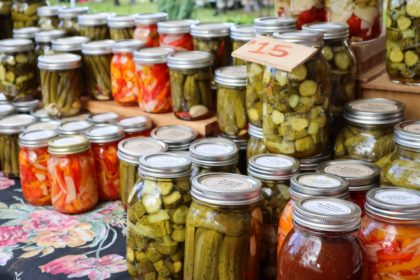
This is the second in a series of articles that TFA will be releasing over the next few months, analyzing trends from our Member Survey.
Fermentation is cloaked in mystery for many consumers — it’s bubbly, slimy, stinky and not always Instagram ready.
So how can fermentation producers appeal to potential consumers? What’s the best way to share fermentation’s flavor and health attributes?
In The Fermentation Association’s membership survey on industry trends, a better-educated consumer was identified as a priority. When asked what would foster increased consumption of fermented foods and beverages, the top item for nearly 70% of producers was greater consumer understanding of fermentation and familiarity with the flavors associated with fermentation.
“More than wanting to sell a product, I want people to know the information,” says Sebastian Vargo of Vargo Brothers Ferments (who is speaking at FERMENTATION 2021). The Chicago-based brand sells ferments like pickles, sauces and kombucha. “I believe preventative health starts with fermentation. I’m explaining the difference between a pickle you see on the shelf versus a pickle you see in the refrigerator. But I’m also teaching people to power up their pantry, sauce up their life with condiments.”
Health vs. Flavor
Producers say they struggle sharing fermentation’s benefits with consumers. There are not enough peer-reviewed scientific studies on many fermented products to be the basis for health claims.
“We feel a responsibility as a fermented food company to entice customers into trying these hugely beneficial and delicious products,” says Savita Moynihan, who owns SavvyKraut in Brighton, UK, with her husband Stevo. But, “with sauerkraut, it is generally understood that raw and unpasteurised kraut is good for you but once you try to elaborate on live culture vs probiotics it gets complicated, more than it needs to be.”
Can a brand claim to include probiotics? Producers feel that guidance is not clear.
“There is confusion here that we feel needs to be ironed out in order to loosen the reins so fermenters can promote their products and their benefits with much more confidence,” she adds.
Moynihan says that, when SavvyKraut sells at farmers markets and local shops, they try to communicate two main things to consumers. First, the health benefits, like enhanced vitamin and nutrient contents, increased fiber and an aid to a diverse gut and digestive system. Second, the delicious flavor.
“The process of fermentation really enhances the flavours and creates an entirely new type of flavour which can elevate any meal,” Moynihan adds.
Lack of Tastings Hurting Efforts
One of the best ways to familiarize consumers with fermentation is for them to taste a product — flavor is a great marketing tool. But COVID-19 has hurt these efforts. Producers are unable to stage in-store demonstrations, offer samples at farmer’s markets or host in-person events. This has been especially hard for kombucha brewers, says Hannah Crum(who is also speaking at FERMENTATION 2021), president of Kombucha Brewers International (KBI).
“We still have such a big part of the population who don’t drink kombucha or don’t even know about [it]; we still have a lot of work in education,” Crum says.
Joshua Rood, CEO of Dr Hops Hard Kombucha, confirms, adding: “It continues to be very difficult to grow our brand and the whole category without live events.”
“The inability to do live tastings in 2020 had a significant diminishing impact on our sales during the pandemic,” he continues. “One of our main distinctions as a brand is superior taste. Consumers, however, do not believe claims about that unless they experience it for themselves. Even now we are significantly hampered by the lack of large beer festivals and street fairs. An artisanal craft brand like Dr Hops needs those live interactions!”
The Knowledge Gap
Despite the lack of in-store tastings, experts at New Hope Network (producers of the Natural Products Expos) say brands have a great opportunity — now, more than ever, during the COVID-19 pandemic — to connect with their consumers.
New Hope’s 2021 Changing Consumer Survey found U.S. consumers are not satisfied with their current health. Only 8% say they’re “extremely satisfied” with their health today, compared with 20% in 2017. Nearly 80% of consumers understand that diet greatly influences their health (79%). But achieving good health is both a goal and a struggle for consumers — and this is where brands can step in.
“There’s a gap to be bridged,” says Eric Pierce, vice president of business development for New Hope Network, during a session “Understanding Your Consumers” at the most recent Expo East. “I see it as our opportunity and our responsibility to help consumers translate healthy intentions into healthy behavior, either in how we’re educating them in our stores, the products that we’re innovating or the ways we’re communicating. Getting better at communicating can help them with solutions.”
A consistent, transparent, well-communicated message — from product label to social media page to website — is important. Pierce says consumers quickly see past “shallow marketing claims.”
“Leave a trail of breadcrumbs people can find,” Pierce advises. “You don’t have to communicate everything all at once, but allow people to follow a trail to the deeper story. When consumers want to find that trail, if it’s not there, they’ll quickly write you off as shallow with unbacked claims.”
Amanda Hartt, market research manager at New Hope, suggests putting a QR code on a product label that links to the science backing the benefits of your ingredients. Or partnering with a registered dietitian on social media to highlight how to use your product as part of a healthy diet.
[To learn more about this topic, register for FERMENTATION 2021 to hear one of the keynote panels “Educating Consumers About Fermentation.”]